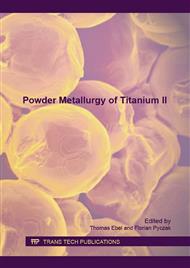[1]
Marc Long, H.J. Rack* Titanium alloys in total joint replacement—a materials science perspective Biomaterials 19 (1998) 1621-1639.
DOI: 10.1016/s0142-9612(97)00146-4
Google Scholar
[2]
M. Geetha, A. K. Singh, R. Ashokamani, A.K. Gogia, Ti based biomaterials, the ultimate choice for orthopaedic implants - A review. Progress in Materials Science 54 (2009) 397.
DOI: 10.1016/j.pmatsci.2008.06.004
Google Scholar
[3]
David F. Williams, On the mechanisms of biocompatibility, Biomaterials, 30 (2009) 5897-5909.
Google Scholar
[4]
D. Mihov, B. Katerska, Some Biocompatible Materials Used in Medical Pratice, Trakia Journal of Science, 8 (2010) 119-125.
Google Scholar
[5]
L. Bolzoni P.G. Esteban E.M. Ruiz-Navas,E. Gordo, Mechanical behaviour of pressed and sintered titanium alloys obtained from master alloy addition powders, In Journal of the Mechanical Behaviour of Biomedical Materials15 (2012) 33-45.
DOI: 10.1016/j.jmbbm.2012.05.019
Google Scholar
[6]
Euro PM 2011- Powder Injection Moulding: Process & Applications (MIM versus Investment Casting-Real Overlap for similar parts-Manuel Caballero, Technical Director ESRIMESA/MIMECRISA).
Google Scholar
[7]
Q. Wei, Influence of oxygen content on microstructure and mechanical properties of Ti–Nb–Ta–Zr alloy, Materials and Design, 32 (2011) 2934-2939.
DOI: 10.1016/j.matdes.2010.11.049
Google Scholar
[8]
Y.H. Hon, J.Y. Wang, Y. N Pan, Composition/Phase Structure and Properties of Titanium-Niobium Alloys, Materials Transactions, 44 (2003) 2384-2390.
DOI: 10.2320/matertrans.44.2384
Google Scholar
[9]
M. Niinomi, Recent metallic materials for biomedical applications, Metallurgical and Materials Transcations A, 33 (2002) 477-486.
DOI: 10.1007/s11661-002-0109-2
Google Scholar
[10]
K.K. Wang, Microstructure and properties of new beta titanium alloys, Ti-12Mo-6Zr-2Fe, developed for surgical implants, Medical Applications of Titanium and its Alloys, ASTM 1272, ASTM International (1996) 76-87.
DOI: 10.1520/stp16071s
Google Scholar
[11]
D. Mareci, R Chelariu, D.M. Gordin, G. Ungureanu, T. Gloriant, Comparative corrosion study of Ti-Ta alloys for dental applications, ActaBiomaterialia, 5 (2009) 3625-3639.
DOI: 10.1016/j.actbio.2009.05.037
Google Scholar
[12]
Y.L. Zhou, M. Niinomi, T. Akahori, Dynamic Young's Modulus and Mechanical Properties of Ti–Hf Alloys, Materials Transactions, 45 (2004) 1549-1554.
DOI: 10.2320/matertrans.45.1549
Google Scholar
[13]
M. Tane, T. Nakano, S. Kuramoto, M. Hara, M. Niinomi, N. Akesue, T. Yano, H. Nakajima, Low Young's modulus in Ti–Nb–Ta–Zr–O alloys: Cold working and oxygen effects, Actamaterialia, 59 (2011) 6975-6988.
DOI: 10.1016/j.actamat.2011.07.050
Google Scholar
[14]
D.Q. Martins, W.R. Osorio, M.E.P. Souza, R. Caram, A. Garcia, Effects of Zr content on microstructure and corrosion resistance of Ti–30Nb–Zr casting alloys for biomedical applications, ElectrochimicaActa, 53 (2008) 2809-2817.
DOI: 10.1016/j.electacta.2007.10.060
Google Scholar
[15]
E.B. Taddei, V.A.R. Henriques, C. R:M. Silva, Carlos Cairo, Production of new titanium alloy for orthopedic implants, Materials Science and Engineering: C, 24 (2004) 683-687.
DOI: 10.1016/j.msec.2004.08.011
Google Scholar
[16]
D.R. Sumner, T.M. Turner, R. Igloria, R.M. Urban, J.O. Galante, Functional adaptation and ingrowth of bone vary as a function of hip implant stiffness, Journal of Biomechanics, 31 (1998) 909-917.
DOI: 10.1016/s0021-9290(98)00096-7
Google Scholar
[17]
Huihong Liu, MitsuoNiinomi, Masaaki Nakai, Junko Heida, Ken Cho, Bending springback behaviour related to deformation-induced phase tranformations in Ti-12Cr and Ti-29Nb-13Ta-4. 6Zr alloys for spinal fixation applications, Journal of the Mechanical Behavior of Biomedical Materials, 34 (2014).
DOI: 10.1016/j.jmbbm.2014.01.013
Google Scholar
[18]
D. Zhao, K. Chang, T. Ebel, Ma Qian, R. Willumeit, Ming yan, F. Pyszak, Microstructure and mechanical behaviour of metal injection molded TI-Ni binary alloys as biomedical material, Journal of the Mechanical Behavior of Biomedical Materials, 28 (2013).
DOI: 10.1016/j.jmbbm.2013.08.013
Google Scholar
[19]
T. Beißig, Karbidausscheidungen bei ß-Titanlegierungen im MIM-Prozess, Masterarbeit (2014), in German.
Google Scholar
[20]
L. S. Moroz, B.B. Chechwlin, I.V. Dolin, L.V. Butalov, S.M. Shul'kin, A.P. Goryachev, TitaniumandItsAlloys, Sudpromgiz, Leningrad (1960) 185-190.
Google Scholar
[21]
G. A: Salishchev, S. Yu. Mironov, Effect of Grain Size on Mechanical Properties of Commercial Pure Titanium, Russian Physics Journal, 44 (6) (2001) 596-601.
Google Scholar
[22]
Y. Kawabe, S. Muneki, Strengthening Capability of Beta Titanium Alloys, in : Beta Titanium Alloys of the 1990's, D. Eylon et al. (eds. ), TMS, Warrendale, PA, USA (1993) 187.
Google Scholar
[23]
Yuhua Li, CHao Yang, Haidong Zhao, Shengguan Qu, New Developments of Ti-Based Alloys for Biomedical Applications, Materials, 7 (2014) 1709-1800.
DOI: 10.3390/ma7031709
Google Scholar
[24]
Y. Okazaki, Y. Ito, A. Ito, T. Tateishi, New Titanium Alloys To Be Considered For Medical Implant, Medical Applications of Ti and Ti Alloys, S:A. Brown, J.E. Lemons, Eds., Medical applications of Ti and its alloys : The material and biological issues, STP 1272, AmericanSociety for Testing and Materials (1996).
DOI: 10.1520/stp16069s
Google Scholar


